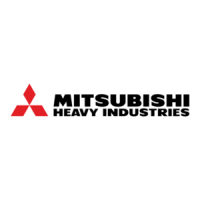
Do you have a question about the Mitsubishi Heavy Industries DXK12Z2-S and is the answer not in the manual?
| Cooling Capacity | 3.5 kW |
|---|---|
| Heating Capacity | 4.0 kW |
| Power Supply | 220-240 V, 50 Hz |
| Type | Split System |
| Indoor Unit Noise Level | 21 dB |
| Outdoor Unit Noise Level | 49 dB |
Essential safety measures for installing the air conditioner to prevent hazards like electric shock or fire.
Guidelines for safe operation, avoiding exposure to cooling air and handling controls properly.
Advice on handling the unit during relocation or when needing repairs, emphasizing professional service.
Identifies key parts of the indoor unit, including air inlet, filters, and outlets.
Details the components of the outdoor unit, such as air intake and outlet.
Locates the receiver for the remote control signals on the indoor unit.
Lists essential accessories provided with the air conditioner, like remote controls and filters.
Explains the buttons and indicators on the remote control for various operations.
Step-by-step guide to set the current time on the remote control for accurate timer functions.
Details how the unit automatically selects the operating mode based on room temperature.
Explains how to adjust temperature settings during AUTO mode operation.
Describes the options for setting the fan speed (AUTO, HI, MED, LO).
Guides on operating the unit in specific modes like cooling, heating, drying, and fan only.
Outlines the operational range and specific characteristics of the heat mode, including defrosting.
Explains the mechanism and capacity of heat mode operation, including defrosting.
Explains how to control the direction of air flow using the remote control.
Describes the automatic control of fan speed and air flow for efficient room conditioning.
Details how to set the Sleep timer for automatic unit control.
Details how to set the Off-Timer for automatic unit shutdown.
Details how to set the On-Timer for automatic unit startup.
Explains how to combine Sleep and On-Timer operations for multi-stage scheduling.
Covers setting timers for both start and stop operations to run daily at set times.
Describes special functions like Amenity facility for enhanced comfort.
Details the Allergen Clear function for improved air quality.
Explains how to use High Power for quick conditioning and Economy for energy saving.
How to run the CLEAN operation to remove moisture and prevent mold.
Explains how to operate the unit manually without the remote control.
Explains the auto-restart function after power failure.
Guides on setting the unit's location to optimize airflow range.
Illustrates airflow patterns based on installation position for effective conditioning.
Instructions for replacing exhausted batteries in the remote control.
Guidance on installing the remote control holder on a wall or pillar.
Important warnings regarding the proper handling and placement of the remote control.
Steps to take when the unit fails to respond to the remote control.
Tips for economic and comfortable use of the air conditioner.
Initial steps to take before performing any maintenance tasks on the unit.
Routine maintenance tasks to perform on the unit during the active operational season.
Instructions on how to open, close, remove, and install the air inlet panel for cleaning.
Procedures for preparing the unit for storage at the end of the cooling/heating season.
Procedures for checking and preparing the unit at the start of the cooling/heating season.
Instructions for installing, inspecting, and replacing air-cleaning filters.
Criteria for selecting an appropriate location for the indoor and outdoor units.
Guidance on minimizing operational noise and vibration from the unit.
Recommendation for periodic professional inspection and maintenance of the unit.
Basic checks to perform before calling a service technician for common problems.
Explains the 3-minute delay before restarting the unit after it has been stopped.
Notes on airflow behavior during heating and dry operation, including defrosting.
Explains steam escape during cooling and common operational sounds like gurgling or cracking.
Information on power failure restart, remote signal reception, and fan operation after stopping.
Lists situations that require immediate contact with the dealer for service.
Explains how to interpret indicator lights for self-diagnosis of unit errors.
